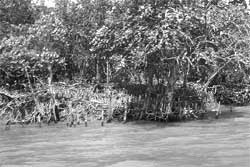Restoring mangroves
 during the 1980s, cyclones ravaged Bangladesh, left millions of people homeless and devastated thousands of hectares of prime agricultural land. Remote sensing maps clearly indicated that wherever mangrove forests were destroyed, there were more damages.
during the 1980s, cyclones ravaged Bangladesh, left millions of people homeless and devastated thousands of hectares of prime agricultural land. Remote sensing maps clearly indicated that wherever mangrove forests were destroyed, there were more damages.
In India, too, the pressures of increasing population, food production and industrial and urban development have led to large-scale destruction of mangroves. There are large pockets of mangrove forests in the Sundarbans, the Mahanadi delta and several parts of both the eastern and westers coasts, including the Pichavaram forests in Tamil Nadu.
Some 35 per cent of the Indian mangroves were lost between 1957 and 1987. Mangroves offer high levels of protection against coastal storms and are considered natural barriers against rise in sea level.
During the 1980s, restoration of the mangrove areas began through efforts by the International Tropical Timber Organisation and the establishment of the International Society for Mangrove Ecosystem.
In India, the department of biotechnology of the ministry of science and technology encouraged such efforts. Subsequently, a research team of the Chennai-based M S Swaminathan Research Foundation (mssrf) initiated research to propagate plant species of mangroves in large numbers using both conventional and biotechnological approaches.
A Mangrove Genetic Resource Conservation Centre ( mgrcc ) was established at Pichavaram to maintain a field gene bank of about 22 species. Using tissue culture and then field transfer, the centre has been highly-successful in propagating mangrove species such as Acanthus illicifolius , Heretiera fomes and Xylocarpus granatum.
In December 1995, about 55,000 plants species belonging to 16 genera were transferred to the field. And the survival rate in the degraded areas was as high as 70 per cent. All the work is being undertaken with the help of local communities and the forest department officials (Diversity , Vol 15, No 2).
The mssrf project is the first such project that has developed successful propagation methods to restore the mangrove forests. Research into the biochemical properties of mangroves is also underway since many species have proven medicinal value. mssrf and its associates are now looking into the molecular mechanisms controlling high levels of salt tolerance in mangroves.
Related Content
- Action taken report by the District Magistrate and Collector, South 24 Parganas on steps taken to prevent coastal erosion, Sagar Island, West Bengal, 22/02/2025
- Report by Deputy Salt Commissioner, Mumbai regarding steps taken to remove C&D waste from salt pans, Mumbai, Maharashtra, 12/10/2023
- Joint committee report on the impact of sea level rise on the islands and frame policy and measures to protect these islands, 10/10/2023
- Decades of mangrove forest change: what does it mean for nature, people and the climate?
- Order of the National Green Tribunal regarding disposal of debris on the salt pans and encroachment, Mumbai, Maharashtra, 15/03/2023
- Report by the Karnataka State Pollution Control Board regarding illegal mining in Palguni and Nethravathi rivers, Dakshina Kannada district, Karnataka, 09/03/2023
